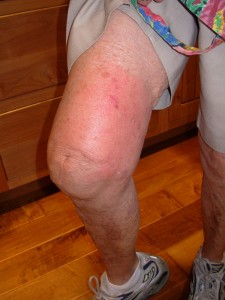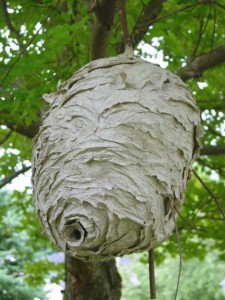This gal demands respect along with her 700 to 800 sisters if the colony reaches its peak. Actually the Bald Faced Hornet is just a larger Yellow Jacket not a Hornet. Don’t ask me, I’m not an entomologist but I did spend the night at a Holiday Inn.
This Hornet makes a beautiful paper nest usually round in shape. As the colony grows they actually remove some of the paper walls inside to make more room and add that paper to the outside shell. I’ve seen nests that are 4 feet long. They get the material for the nest from wood such as your privacy fence, picnic table etc. Their powerful jaws chew the wood and it mixes with their saliva to turn it into the paper they need. As the nest gets bigger they incorporate branches or objects (if it’s on the side of a building) which adds to its strength.
Bald faced Hornets are quite protective of the nest and if it is disturbed watch out! There is usually one or two guards at the entry and they will attack. If word gets out and more come you better run to the nearest house or cover that you can. These beauties can and will sting repeatedly and live to tell about it. Unlike the bee who dies after stinging you just once.
If at all possible you should leave the nest alone that is if it is up real high or out of the way. The nest is abandoned usually after the first
frost so you can safely have a nice trophy for your game room. Plus, these Hornets eat other insects so they are beneficial to your home and landscape. If however, it’s at all possible you may get attacked then it’s time for action.
There are many sites that show you how to ‘do it yourself’ but this is not one of them. I’ll tell you how the pros do it but if you ‘DIY’, then you’re on your own, literally.
The trick is, as with a lot of stinging pest work is to do it at night or on a rainy day (which is what I prefer). All the workers are usually present and you can make short work of it. The Bald Faced Hornet only has as a general rule one entry hole. Using minimal lights an exterminator gets right up to the entry and injects his product. Wasp freeze spray, dusts or other quick knock down aerosols will suffice. Then a piece of duct tape over the hole and slip a bag up over the nest. With snips he cuts the branch away and the nest gets neatly tied up and hauled away. You may be watching from a screen porch or a safe distance and watching this all happen in less than 5 minutes you curse the day you took my advice. A pro makes it look easy and you may feel gipped when he hands you the bill but believe me, it’s money well spent if you don’t have the tools or training.
Possible problems may include,
Tearing a new opening in nest with too much pressure from spray
Multiple branches intertwined with nest
Using too much light and getting stung
Losing your footing if you’re using a ladder and you get startled or stung
Tape doesn’t stick from too much spray
Unseen secondary exit hole
Not familiar with spray can and how it shoots resulting in weak or missed shot
Hesitating from nervousness or unable to aim because of fear (it happens all the time)
 Like I said the pros make it look easy and for some it is; but that is why they are professionals right?
Like I said the pros make it look easy and for some it is; but that is why they are professionals right?
Any stinging pest work is dangerous and you should always consider calling a licensed pest control operator for the job. It’s not worth the pain of multiple stings or worse injury just to save a few bucks. If you’re nice they may just clean the nest up for you and let you keep it as your trophy. You can tell your friends anything you like; we bug men are good at keeping secrets.
.
.
To see how the wasp nest was made click here, quite interesting.





